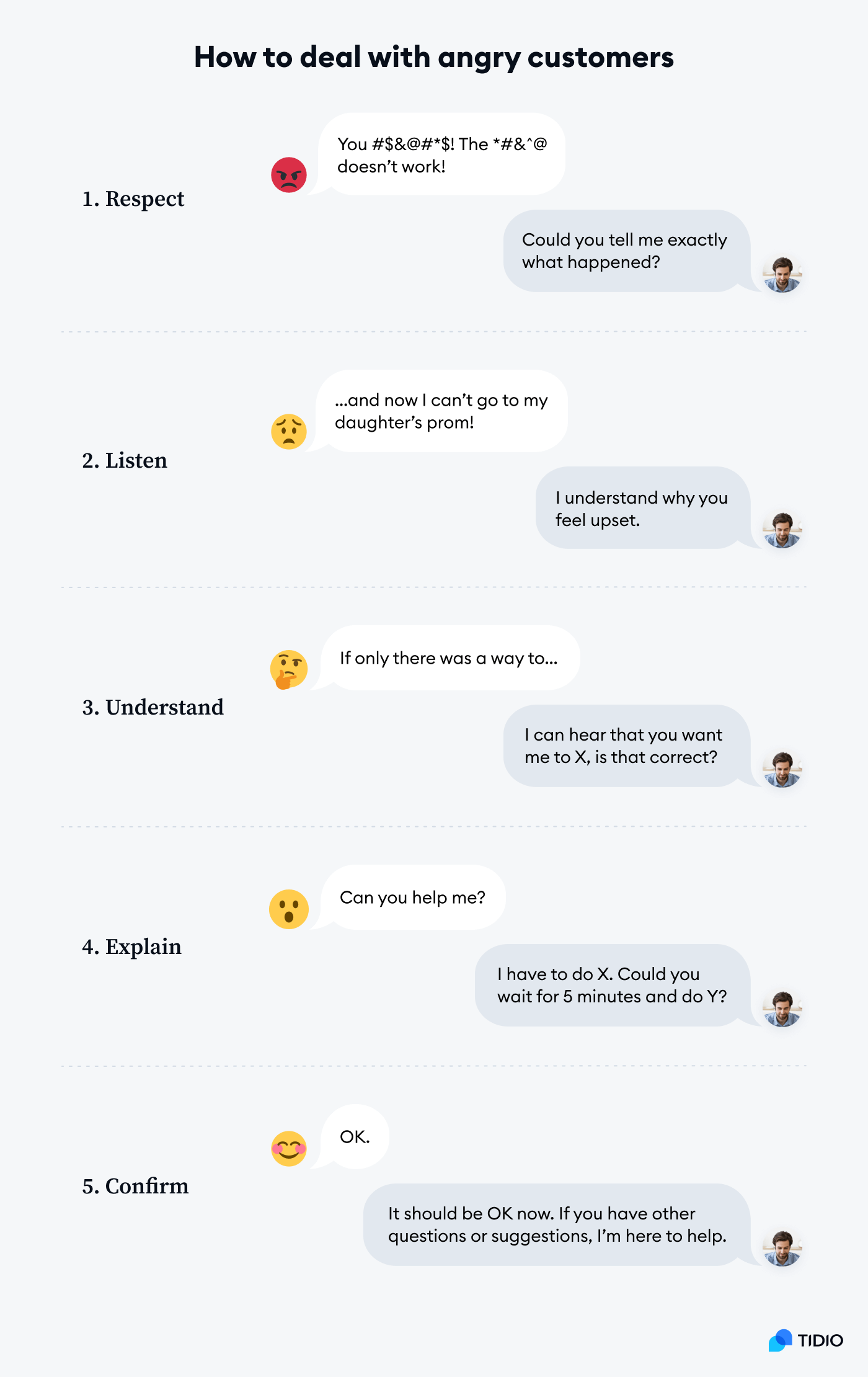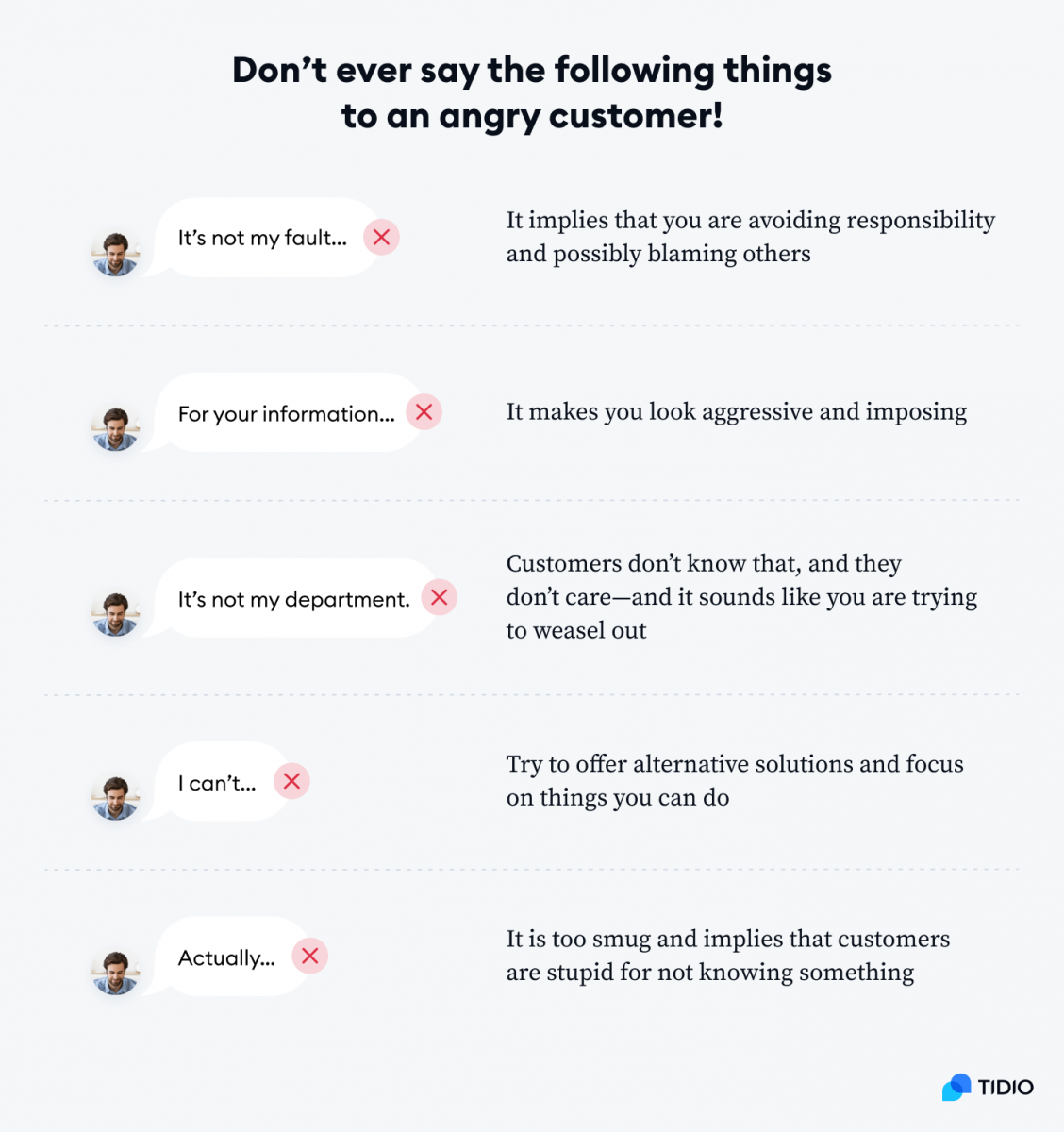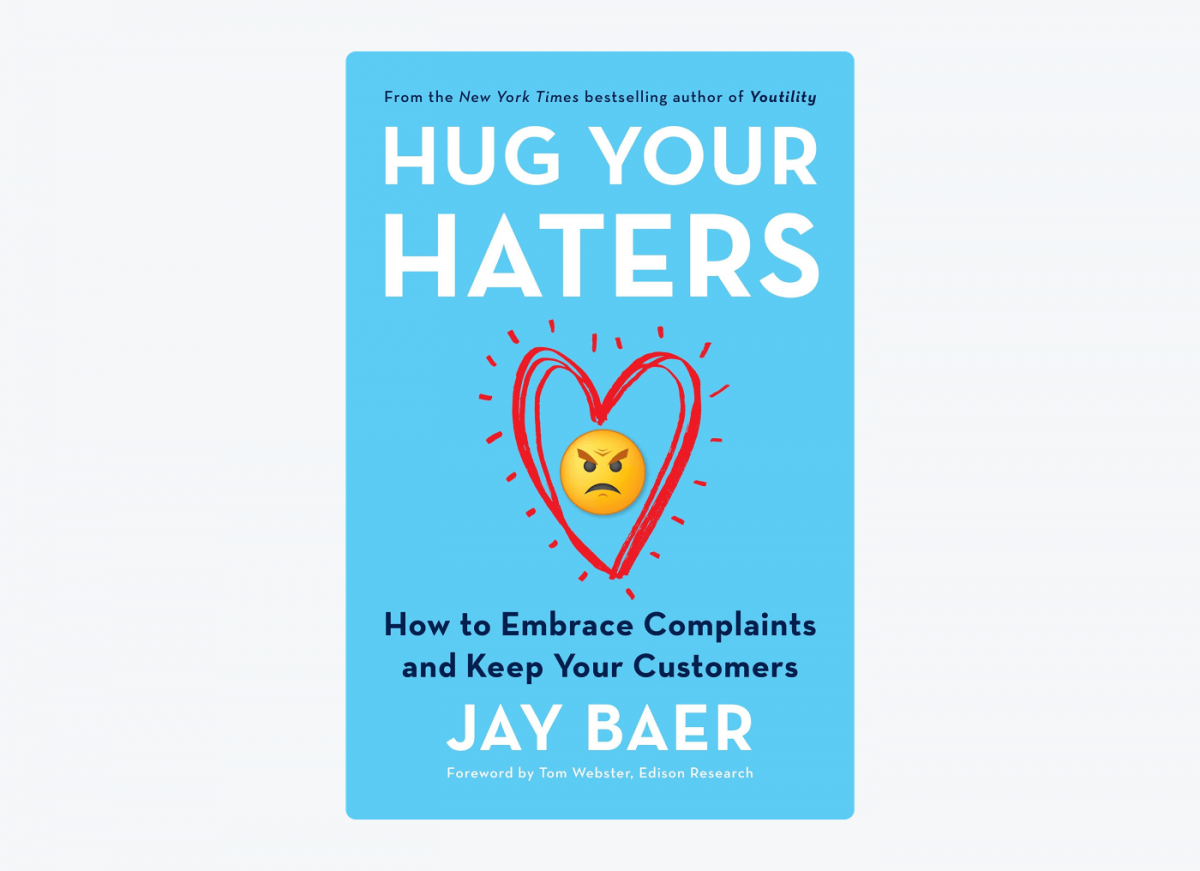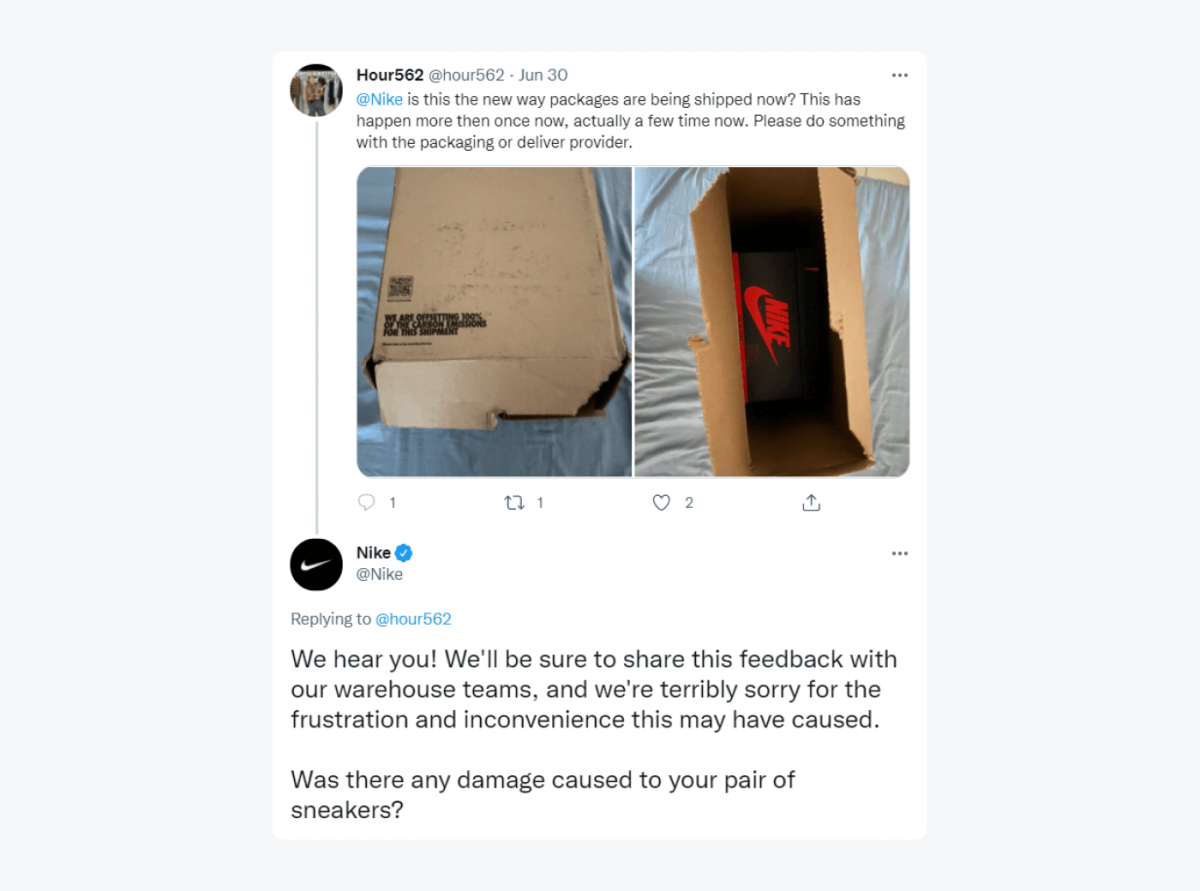Have you seen “Falling Down?”
You might remember a scene with Michael Douglas complaining about a hamburger. With a machine gun in his hand.
It’s just a movie, right?
Let’s check out some recent news:
An irate customer pulled a gun on a Starbucks employee

An angry customer opens fire at Memphis Burger King

If something like this happens to you, call the police. But most angry customers are far less troublesome than they appear. You can deal with them on your own and turn them into happy customers again by following a simple formula.
In this article, you will find out:
- The best ways to deal with difficult customers
- Examples of conversations with angry customers
- How to turn unhappy customers into your best clients
If you want to read some general guides about improving your customer service, you may also be interested in:
- Through the Eyes of the Customer: Ideal Customer Experience in 2021
- 7 Ways to Deliver Excellent Customer Service [Examples & Tips]
- How to Build Strong Customer Relationships
- Customer Success Essentials [Metrics, Stories, & More]
How to deal with an angry customer
An angry customer swears, screams at you, and wants to speak to your manager. They may interrupt you and make unreasonable demands, even if they are the ones to blame. However, you shouldn’t allow them to intimidate you and the best way to approach them is to develop a separate customer service process for dealing with angry clients.
Dealing with difficult customers can be quite challenging. But it gets easier if you don’t take it personally. You need to understand that the customers are not angry at you. You just happen to be the only person they can channel their negative emotions towards.
Learn how to boost client satisfaction with AI-powered customer service
It’s important to establish a connection with the customer and make them realize that you are not their enemy.
The customer stormed in, cursing and calling me names. All I did was simply explain to him that there is no need to swear and that I will do everything in my power to help them with their problem. He quickly calmed down, apologized for his behavior, and explained to me that he had a rough day. The rest of the conversation went smoothly, and we quickly resolved his issue together.

Additionally, dealing with angry customers on the phone can be quite different from writing an email to irate customers. You should develop your own framework for your specific industry and type of customer support channels.
However, you can start with this universal process for dealing with difficult clients.

1. Put yourself in their shoes
As an agent, you should never get emotionally involved in the conversation. We might not like what the customer is saying or not agree with them. But getting angry at them and losing our composure is like adding fuel to the fire. We need to remain calm at all times and always try to adapt to the situation.
First, try to understand why the customer is angry. They come to you with a problem, but that doesn’t mean that the problem itself is the cause of their anger.
Customers may inquire about all sorts of things. Sometimes they are just curious or want to learn more about your product. But, if you keep them on hold for too long or reassign them to different customer service agents multiple times, they turn into angry customers.
The very same process that was supposed to help them, made them irate! And it happens all the time. About 56% of customers have to re-explain an issue when speaking to customer service.
What makes customers angry:
- Having to re-explain their problem to multiple people
- Receiving incomplete or incorrect information
- When the problem with a product or service prevents them from doing something urgent
- Being put on hold for too long
All of these lead to one thing—
The customer feels a company is wasting their time and, thus, disrespecting them.
Most of the time, all that your customers want is an uninterrupted, consistently good experience. When something is wrong, they want to clarify the matter. But when you toss them around like a hot potato or don’t give them the attention they deserve, they become more irritated.
Use phrases like the ones below to determine how the customer feels:
- Can you tell me a little more about the problem, please?
- Could you tell me exactly what happened?
Ask customers to give you more details. They may describe how the problem affects their lives.
For example, let’s assume that your delivery is late. And your customers need to order an anniversary gift for someone very important to them from your online store. No wonder they would feel irritated!
Use web chat instead of phone or email-based customer service. This way, you won’t make your customers frustrated by having to re-explain their issue several times. You can assign conversations to different agents, who can still check the whole conversation history.
2. Use empathy and active listening skills
Sometimes customers feel like they want to bury your company and make destroying your reputation their life’s goal.
But, let’s be honest—
For how long can they feel that way? 10 minutes?
Probably, it is enough to write a negative review on social media. But if they reach your customer service, you can let them blow off some steam. The majority of angry customers just want you to listen to their story and show some empathy.
Being a good agent is not about being positive and cheerful all the time. Sometimes, our cheerfulness can come off as mockery and make the situation worse.
I was dealing with an angry customer who had an issue with their account. I was able to calm the customer down and explain everything. We were just about done with the case. But then, I used a smiley face at the end of my message. It caused the customer to follow up with a 1-page paragraph explaining how insensitive I was.

Make sure that angry customers feel heard. You should stay calm, but acknowledge the anger early in the conversation and adjust your tone.
Good communication skills are essential in this situation. You can use phrases like:
- I understand you. I would feel frustrated too in that situation.
- You’re right. This is unacceptable. I’m sorry you’ve had to deal with this.
- This is serious. Thank you very much for alerting us about this.
- I understand why you feel upset. I appreciate you bringing this to our attention
- I’m incredibly sorry for your bad experience with us. I appreciate your patience”
Even if something is their fault, you should never argue with them. But it doesn’t mean that you should give in to their demands. You can be assertive but still very empathic and respectful.
Don’t tell an irate customer to calm down or how to feel. Try to reuse things that they have already said, but without making new assumptions.
Try to rephrase what they are saying to you. Use their own words.
- I want to make sure I understand what you’re telling me. I’m hearing that…
- So, you have problems with [product] and now you can’t [do something], is that correct?
Obviously, you can’t just copy/paste their messages verbatim. But try to summarize their experience. You are reassuring them that you hear what they say. It’s more than enough to make them far less angry.
Their initial impulse was to attack you. Now they are complaining.
And once they get it off their chests, they feel better. There is no point in writing those 100 negative reviews all over the internet after all.
You can find additional insights in our ultimate guide to customer complaints.
3. Understand the problem and consider your options
At this point, you should be able to tell what the angry client’s motivation is. First of all, try to determine if your customers are genuinely upset or just rude and feel entitled.
There is an interesting concept in Buddhism—a hungry ghost. It is a being that is never satisfied and always wants more. It is similar to what Westerners call a “Karen.”
Some customers are just like that. They aren’t really angry. They are hungry for discounts and attention. The customer’s anger is merely a manifestation of their sense of entitlement.
The “I would have you fired/I want to speak to the manager” attitude is easy to spot a mile off.
So—
How would you handle a dissatisfied customer whom you can never truly satisfy?
Your company should have a strict policy about giving discounts and addressing specific customer requests. Follow the rules and don’t give those people second thoughts. It’s not worth it.
Let’s focus on the upset customers who are genuinely frustrated and have their reasons.
Here’s what to do:
- Gather additional information
- Confirm what the problem is
- If necessary, break the problem into smaller pieces
- Brainstorm possible solutions
- Negotiate
If your customers want to solve their problems and not just trick you into giving them freebies, they will cooperate. It is called interest-based conflict resolution. Their interest is mostly to get things back to normal.
You should remember that you will not be able to always end the conversation on a positive note. Some customers will remain angry just for the sake of it. No matter how hard we try, we will never be able to fully satisfy them.
We have to stand our own ground and explain the situation while keeping the conversation as professional as possible. The customer knows best, but we also deserve respect and decent treatment.


4. Offer a solution and explain what happens next
Once you agree on the course of action, you can proceed to actually solving the issue. Sometimes you’ll need to instruct your customers. Incidentally, this shift of the positions of power is also good for decreasing customers’ anger.
Customers are angry because something unexpected happens, and they can’t control it. They are angry at you because you represent the company. In a way, you are the person “responsible” for the failure.
But, as it happens, you are also the more knowledgeable person out of the two of you. Customers need your expertise and guidance. You can turn from their enemy to their partner within 30 seconds.

However, you must stick to the rules and treat the customer like a partner:
- Don’t be condescending
- Don’t make false promises
- Set a timeframe for solving the issue
- Announce what happens when
- Focus on channeling efforts towards the customer’s problem
Psychologically speaking, customers can’t be angry at you and follow your instructions at the same time. To reduce the cognitive dissonance, they will calm down. After all, why should they follow the instructions of some “stupid jerk?” At this point, they will try to convince themselves that you are on their side.

5. Make sure they are satisfied with the outcome
If you throw a solution at a customer and run away, it will not look particularly good. The customer cannot feel like just another person in line.
Make sure everything is in order. Offer extra help and let him or her ask questions. Don’t push to end the call, even if another customer is waiting.
Some useful phrases that you can use are:
- Let me know if I missed anything. Please don’t hesitate to reach out to me with any other issues.
- I’m glad that we have it all sorted out! Is there anything else I could assist you with today?
After the conversation is over and the customer’s complaint has been resolved, send a follow-up message. You can use a customer satisfaction survey. Measuring the effectiveness of your support on a day-to-day basis will help you improve your customer service skills.
Examples of dealing with three types of angry customers
It is hard to buy a Christmas gift for someone who doesn’t know what they want or like. Or choose a meal. Or do anything.
Some customers are also like that, and they are the hardest to please. But angry customers are angry for a reason. They have a clear problem and once you solve it, they are happy.
Research shows that angry customers are more goal-oriented. It can make your shopping experience more focused and fruitful. And they are more satisfied if their problems have been successfully resolved.
It means that you can turn bad experiences into good ones. And once your customer service team learns how to read your customer’s feelings, angry customers can become your allies!
Here are the most common types of angry customers and different ways to approach them.
1. Customers who vent out on social media
In his book “Hug Your Haters”, Jay Baer defines two core types of dissatisfied customers. Offstage haters and onstage haters. The first ones want their problems to be solved and don’t care how their individual experience corresponds with other customers of a given company.

Onstage haters turn their “righteous” anger into a common cause. They want attention and make their experience something shared by other dissatisfied customers. They write comments and reviews on social media and discussion boards.

You can deal with them by commenting on their reviews and writing direct messages. In many cases, bad reviews are the result of a misunderstanding. You should always reach out to the customers who wrote them. It’s never too late to make things right.
2. Angry customers who make lots of demands
When customers get emotional, it usually means that they want attention. They feel hurt or tricked by your company. Their reactions are exaggerated, and their demands don’t make sense.
Sometimes it feels like negotiating with terrorists. You want them to calm them down, no matter what the cost. But be patient. Take a deep breath. You shouldn’t give them the upper hand or make promises that you can’t keep.
How would you handle an angry customer who makes unreasonable demands?
Just be patient and let them speak. Do not promise anything and ask a lot of questions. In a way, irate customers are just like children who misbehave to get some attention. Instead of making a confrontation, give them an opportunity to be heard.
Customers who make seemingly unreasonable demands could believe it is their only way of being heard. When they find someone who is willing to listen without judgment, they are likely to lower their demands and become a lot more open to searching for shared solutions.

3. Customers who want to stop using your service
Some customers will try to blackmail you by using their ultimate weapon—I will never buy from you again!
While many customers declare that they leave a business after just one bad customer experience, it is rarely the case. According to our study, about 2 in 3 customers give businesses multiple chances to make up for a bad customer experience.
If customers tell you that they want to cancel their subscription, they are usually bluffing. Finding an alternative and starting from scratch can be too much hassle. They are simply trying to get a better negotiating position.
To deal with this type of difficult customer, you can:
- Assure them that your business is going to go the extra mile to make them happy again
- Thank them for bringing their problem with your service to your attention and opportunity to fix it
- Offer them several options to choose from to make their customer experience better (like extra credits or advanced features)
Key Takeaway
Dealing with difficult customers is part of every customer service agent’s job. It can cause you a lot of stress at first. However, if we break the process down into smaller steps and take a measured approach to customers, it becomes easier.
Remember to not treat all angry customers the same way, because the same approach will not work on all of them.
There is no golden rule here. They all have their reasons and whether they are in the right or not, we should always take a moment to understand their case, see where they are coming from and approach them respectively.

Before you get a customer to calm down, you should:
- Acknowledge their anger
- Apologize for the situation
- Learn more about their problem
- Thank them for bringing the problem to your attention
- Try to understand their feelings and motivation
- Rephrase what they say and confirm if you understand them
- Suggest possible solutions and outcomes
- Negotiate different options
- Be sincere and tell them what you can do and when
- Fix the problem
- Make sure that customers are happy with the result

